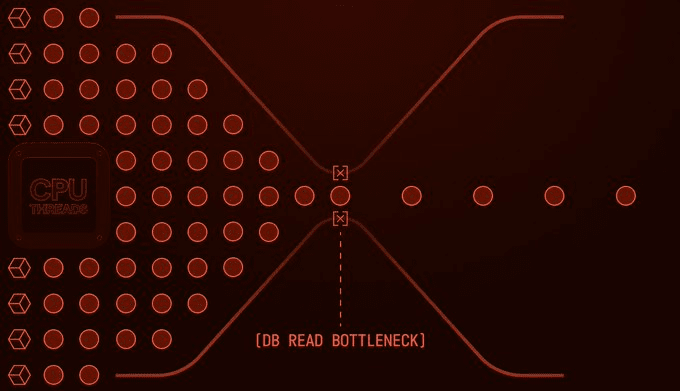In blockchain, we are witnessing an interesting paradox.
On one hand, validators and nodes run on cutting-edge hardware: multi-core CPUs, high-speed SSDs, ample RAM – capable of handling enormous parallel workloads.
On the other hand, the way blockchain accesses databases remains outdated, reminiscent of single-threaded systems from the mid-2000s. This mismatch creates a severe bottleneck, especially in data reading, hindering scalability and practical application. Imagine 8 powerful CPU cores trying to drink from a tiny straw at the same time – that's the most vivid image of waste when lacking simultaneous database read capability.

Database Read Bottleneck
The core of the issue lies in how blockchain manages state – the ledger of all accounts, balances, and smart contract data, stored in systems like LevelDB or RocksDB. In traditional blockchain design (like Ethereum or many other Layer-1s), executing and validating transactions requires reading/writing state in a strictly sequential order. Why? To ensure determinism and consensus: every node must process transactions in the same order to agree on the final state, avoiding conflicts or forks.
But it's here that the bottleneck appears. Modern CPUs with multiple threads (8, 16, or more) can process in parallel. However, lacking a simultaneous database read mechanism, all threads become bottlenecked at a single access point. In the context of high transaction volumes – like DeFi transactions, NFT minting, or on-chain gaming – thousands of transactions need to read state data simultaneously. Instead of distributing the load across multiple cores, the system queues them sequentially, leading to:
Latency spikes: Transactions must wait, prolonging block times and user wait times.
Hardware waste: An 8-core CPU operates no differently than a single-core machine from 2008.
Scalability Limit: Blockchain struggles to achieve the performance level of Web2 (e.g., Visa 65,000 TPS), only tapping into a small fraction of potential.
This "bottleneck" effect is even more severe in monolithic blockchains, where execution, consensus, and data availability are tightly coupled. As demand surges due to DeFi, GameFi, SocialFi, data reading rather than computation has become the main bottleneck.
The diagram illustrates this very clearly. On the left, a cluster of CPU streams (represented by red dots, squares) starts wide, symbolizing abundant parallel capacity. But when it reaches the database read point (DB READ BOTTLENECK), the path narrows into a single file. Only a few dots pass through, while the rest pile up. This is not just theoretical: many validators report CPU idleness of over 90% during high load, simply due to DB access not keeping up.
In summary, without simultaneous access, blockchain is no different from a highway forced into a single-lane dirt road. The result: congestion, frustration, and a loss of the smooth experience necessary for widespread adoption.
Altius emerges: a modular solution for simultaneous DB access.
Altius is a pioneering blockchain infrastructure project addressing this bottleneck head-on by redesigning the execution layer in a modular, VM-agnostic manner with strong parallelization.
Instead of creating another Layer-1 or Layer-2, Altius focuses on an independent execution engine, separating execution from consensus. This modular approach allows chains to upgrade performance without overhauling the entire architecture. Key innovations include:
Data sharding for simultaneous read/write: Altius breaks down the blockchain state into multiple shards, distributing data across nodes. This allows multiple streams to read (and even write) different shards in parallel without conflict. No longer a single straw, but an entire multi-lane pipeline.
Parallel execution with decisive concurrency: Applying Static Single Assignment (SSA) and Optimistic Concurrency Control (OCC) techniques, Altius parallelizes smart contract execution at the opcode level. Transactions are processed concurrently whenever possible, and conflicts are resolved decisively to maintain consensus. Performance spikes, aiming for "gigagas" speeds while remaining secure.
VM-agnostic design: Compatible with EVM, SVM, or any VM, Altius ensures that Ethereum, Solana, and other chains can easily integrate. It supports both specialized chains (trading, gaming) and narrows the interaction gap between ecosystems.
Expanding DB access capabilities: Optimizing interaction with the database maximizes the use of modern hardware, reduces node idle time, and allows high-frequency applications to operate smoothly like centralized systems.
As a result, blockchain can scale to serve the masses without sacrificing decentralization. In high-performance scenarios (e.g., order-book chains inspired by Hyperliquid), Altius eliminates the read bottleneck, achieving finality under one second and a smooth Web2-like UX.
Why this is important for the future of blockchain
Many skeptics argue that too much infrastructure is merely vanity, but as Huang emphasizes, the gap from the current state to true mainstream adoption is still vast. Building simultaneous DB access capability is not just about adding more roads and bridges – it's about building the right kind of infrastructure. Altius is proof, focusing on long-term foundations, with a clear goal, empowering both devs and users.
In the multichain era, where specialized AppChains are increasingly prevalent, solutions like Altius ensure performance is not overlooked. By eliminating the DB read bottleneck, Altius paves the way for the user experience they love – fast, reliable, scalable – taking blockchain beyond niche applications to enter everyday life. If you are a builder or Web3 investor, keep an eye on Altius: they not only untie a knot but are also "insuring the future" for the entire ecosystem.
